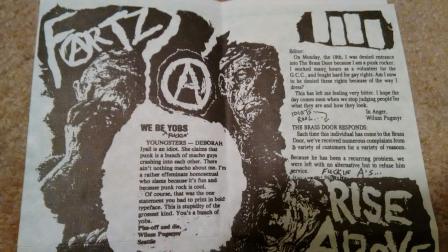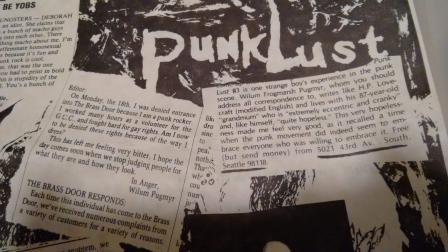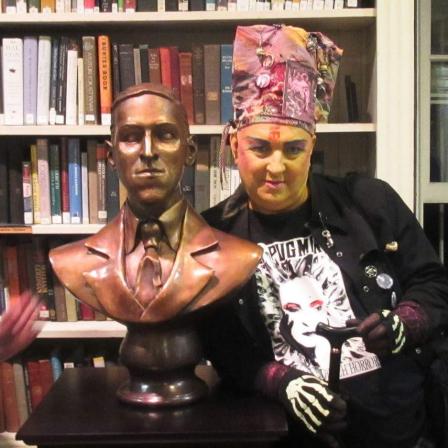When young Wilum Pugmire returned from his two-year Mormon mission in Omagh, Northern Ireland, he was a most unlikely candidate to become a punk rebel. True, young men and women were beginning to come out of the closet as gay. Wilum knew damn well he was gay by that point. He was also already carrying on a correspondence with Robert Bloch, one of the premier horror authors of the day, and he had discovered the writer who would inspire the rest of his working life, H. P. Lovecraft. Yes, he was already an odd, odd, young man.

What he wasn’t was the outspoken, in-your-face (in the nicest possible way) troublemaker that he was about to become. Nope. He was just another repressed gay kid with a feeling that he just didn’t fit in anywhere.
What Wilum needed was punk. When it arrived in the Seattle area in 1979, he was there, already an outsider, already out, already head-shrunk and excommunicated from the Mormon church, and tired of being walked on by various old men and institutions. It’s hard to explain how revolutionary the whole punk thing was to the people who had been too young to be hippies and thought the whole peace and love thing had limited application anyway. Wilum was one of those, and he got it right away.
He almost immediately began to attend shows, including early shows from bands traveling up and down the coast and booking into old clubhouses like Washington Square. There were no punk clubs to show at yet, that didn’t happen until 1980, and things didn’t really get going until 1981. In 1980 clubs opened, and punks were to be seen here and there on the street.
By 1981 there was stuff to do every weekend and some weeknights, and there were even places to buy punk records. This probably seems terribly late to people from England and from the big cities like New York and Los Angeles, but everything spread very slowly back then, and it took time for things to travel to a relatively isolated backwoods place like Seattle.
By 1981, Wilum was a fixture on the scene. He’d already done a few horror zines, and decided to do the one he will always be remembered for, Punk Lust, in early 1981. Punk Lust reviewed shows, excoriated venues/stores/clubs for being anti-punk, and generally supported expanding punk rebellion to include the gay queen lifestyle that Wilum found so liberating.
Wilum got spit on a lot. He got yelled at by carloads of suburban guys who would come into town to beat up punks. Even punks thought he might be a Nazi because he sometimes wore a swastika armband, and some of them were afraid of him, which was silly because anyone who ever spoke to him knew that he was the sweetest person ever. But, he was six feet tall, wasn’t some reedy child, and boy did he have attitude.
The first issue of Punk Lust arrived in May of 1981. Wilum reviewed a show at the Showbox headlined by U.K. Decay and opened by local bands the Fartz and the Refuzors, two now legendary bands from Seattle punk history. The Fartz are also mentioned in the issue as Loud Fart and his girlfriend Heidi were also doing a zine at the time and they got reviewed. They returned the favor by publishing a letter from him complaining about the local posh gay bar refusing him admittance for dressing punk.
The best bit of the first issue sez “I don’t hardly ever go to bars or clubs. I am anti-social; I leave drugs to the hippies; booze is a bore, and I loathe riding the bus at night, and I ain’t got no friends cos I’m a hermit so I an’t get rides to gigs. So that’s why there ain’t no bars/clubs reviewed herein.” And that pretty much was Wilum and all the introverted punks he wrote for. As he said “This is why I love punk music. It fuckin’ awakened my mind. I’ve been an apathetic shell of ephemeral feelings for so long. No feelings! Didn’t give a toss.”
Wilum distributed the zine by city bus to the various stores that would carry it. An average run was around 200 copies, and they vanished into people’s lives as zines were always meant to do. He gave away copies too. One regular recipient worked at the downtown Seattle Public Library and eventually ended up with a complete run of Punk Lust given to him by the author while checking out books.
Wilum lived a completely punk life, washing dishes for a living at all of Seattle’s finest establishments (Bon Marche, Nordstrom’s, the Space Needle – he was a classicist) for the next fifteen years, publishing Punk Lust when he could through the vicissitudes of gaining and losing various living situations. He was one of those people who should have had a devoted lover to take care of him, only it seemed like he attracted and was attracted to those who needed care from him instead.
This came to a tragic end in March of 1995, when Wilum lost the love of his life to an alcohol and heroin overdose. Todd (the boy, as Wilum always referred to him in print) died in Wilum’s stunned and disbelieving arms. Tragically, the very night of the boy’s death, Wilum had finished up a story written in memoriam for his mentor Robert Bloch. If he hadn’t been in the midst of post-writing euphoria and sleepless, he would never have been awake to bring the boy inside and experience that terrible event.
The death changed him, and in the end made him even more punk, and a better writer. He became less about how things looked and more about how they twisted between seeming and being. For a horror writer, it was just the thing. For the man, it was a turning point. He became far more devoted to his writing, and his work began to be published more and recognized.
The last twenty years of his life saw him adapt to the modern world in some mightily weird and wondrous ways. The horror genre adapted to modern technology early and often, and Wilum’s YouTube presence for the last ten years of his life was inspirational and fascinating. As each of his books was released, accompanying videos provided insight into what had gone into them. Unspoken, but always there, was Wilum’s personal style, evoking the madness of Jackie Hell makeup and the might of punk clothes and jewelry. In some ways, the broadcasts took the place of Punk Lust, although the focus was never on punk music.

The last issue of Punk Lust the zine came out in spring of 1997. By that time, he had become a punk icon in the city. As Jessica Amanda Samuelson puts it “It was startling how influential it became. I remember walking about the city with Wilum and every kid with a weird haircut would say ‘Hi Wilum’ as we walked by.” Maybe it’s the weather in the northwest, the eternal gloom of it all, but Punk Lust was the zine for all the iconoclastic kids who were outsiders.
To the kids, it didn’t matter that he was on the cover of the Stranger, or that the Seattle Times had done a profile of him as a local horror writer of note. Nope, what mattered was Wilum the punk.
Wilum himself said it best in the last issue of Punk Lust: “It’s cool, how punk has survived all the media bullshit and all the grunge bullshit, staying true to itself. Punk is just as real, as vital, as it was for me in 1981, which I went to my first hardcore show… I love punk.”


